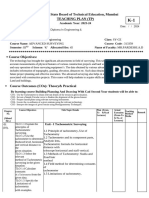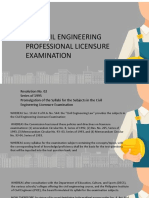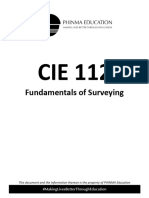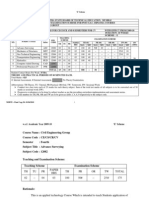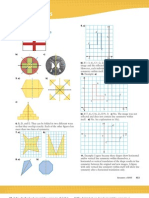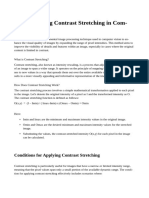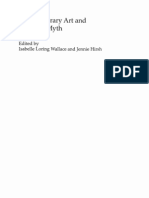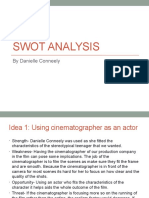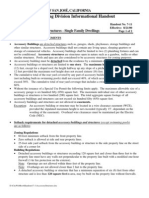Survey II
Survey II
Uploaded by
Anil MarsaniCopyright:
Available Formats
Survey II
Survey II
Uploaded by
Anil MarsaniOriginal Title
Copyright
Available Formats
Share this document
Did you find this document useful?
Is this content inappropriate?
Copyright:
Available Formats
Survey II
Survey II
Uploaded by
Anil MarsaniCopyright:
Available Formats
Survey - II
BEG259CI
YEAR-II SEMESTER-II
Teaching Examination Scheme
Schedule
Final Internal
Hours/ Assessments
Total
Week Theory Practical Theory Practical Marks
Marks Marks
L P T Duration Marks Duration Marks
3 4 1 3 80 - 25 20 25 150
Course Objectives:
After the completion of this course the students will be able to:
Apply the basic principle of surveying for land characterization,
Gain general and theoretical knowledge on plane and topographical surveying of
small area,
Carry out mapping works by both digital and graphical means.
Course Contents:
1.0 Traversing (6hrs)
1.1 Principles and importance of traversing, types of traverse
1.2 Field works for traversing and booking of field notes
1.3 Reduction of reading to angle and bearing
1.4 Angular misclosure and Closing Error
1.5 Traverse adjustment and computation for closed and link traverse -Gale's
Table
1.6 Plotting of traverse survey
1.7 Omitted measurements in traversing
1.8 Instructions to field applications
2. Tacheometry(5 hrs)
2.1 Definitions
2.2 Principle of optical distance measurements
2.3 Systems of tacheometric measurements-Stadia method and tangential method using
vertical staff
2.4 Subtense bar
2.5 Booking and plotting of details
2.6 Sources of errors and precision of tacheometric survey
2.7 Instruction on field work
3. Trigonometric Leveling (4 hrs)
3.1 Problems of heights and distances
3.2 Plane and geodetic trigonometric leveling
3.3 Significance and error ratio
3.4 Instruction on field applications
4. Contouring (4hrs)
4.1 Introduction
4.2 Contour interval and characteristics of contours
4.3 Methods of contouring (direct and indirect)
4.4 Interpolation of contours
4.5 Use of contour map
4.6 Instruction on field works
5. Orientation (3hrs)
5.1 Introduction
5.2 Analytical intersection and resection
5.3 Two point and three point problems and their significance
5.4 Use of geodetic control points
5.5 Instruction on field applications
6. Curves (10 hrs)
6.1 Classification of curves and their common uses
6.2 Elements of simple circular curves
6.3 Setting out of simple circular curves by ordinate from long chord, by offset from
tangents and by deflection angle methods
6.4 Geometry of transition curves and their elements
6.5 Elements of vertical curves and computation of reduced levels of points on curve
6.6 Instruction on field applications
7. Triangulation and Trilateration (4hrs)
7.1 Introduction
7.2 Principal of triangulation
7.3 Purpose of triangulation
7.4 Classification of triangulation
7.5 Layout of triangulation
7.6 Fieldwork of triangulation
8. Photogrammetry and Remote Sensing (3 hrs)
8.1 Introduction to Photogrammetric as a branch of surveying
8.2 Types of aerial photographs
8.3 Scale of vertical photograph
8.4 Relief displacement
8.5 Merits and limitations of Photogrammetric
8.6 Introduction to remote sensing
9. Field Astronomy and GPS System (2 hrs)
9.1 Celestial sphere and spherical triangle
9.2 Characters of spherical triangles
9.3 Merits of field astronomy and GPS system for horizontal control in civil engineering
problems
10. EDM (2 hrs)
10.1 Basic definition
10.2 Classification of EDM instruments
10.3Principle of Electronic Distance Measurement
11. Total Station (2 hrs)
11.1 Introduction
11.2 Features of total station
11.3 Electronic data recording
11.4 Summary of total station characteristics
11.5 field procedures for total station in topographical surveying
Laboratories:
There shall be eight laboratory exercises in this course:
(i) Traverse survey, computation and plotting
(ii) Application of tachometry to measure distance and elevation by the stadia system
including detailing, computation, plotting and contouring
(iii) Intersection and resection using theodolite.
(iv) Establishing of control points by triangulation andTrilateration.
(v) Trigonometric leveling.
(vi) Setting out of simple circular curve, transition curve.
(vii) Demonstration and application of total station.
(viii) Demonstration and application of GPS.
Requirements:
The number of students in each group should not be more than five. A facilitator should not response
more than three groups.
References:
Banister, A. & Raymond, S., "Surveying", ELBS Publication
Punima, B. C., "Surveying", Khanna Publishers
Agor, R., "A Text Book of Surveying and Leveling", Khanna Publishers
Dr.Arrora K. R. , "Surveying", Standard Book House, Delhi
You might also like
- Physics Investgatory ProjectDocument12 pagesPhysics Investgatory ProjectVikash Prasad73% (71)
- Full Notes 1Document252 pagesFull Notes 1علي الخاتمNo ratings yet
- Surveying IIIDocument7 pagesSurveying IIIShaik Jhoir100% (2)
- Ce 120-0: Elementary Surveying Mapúa Institute of TechnologyDocument26 pagesCe 120-0: Elementary Surveying Mapúa Institute of TechnologyLouissa Liendle Ridad100% (1)
- Numerical MethodsDocument3 pagesNumerical MethodsAnil MarsaniNo ratings yet
- Electronic Devices and CircuitsDocument3 pagesElectronic Devices and CircuitsAnil MarsaniNo ratings yet
- Survey IDocument2 pagesSurvey IJunior heroNo ratings yet
- SyllabusDocument3 pagesSyllabusGanesh Raj SharmaNo ratings yet
- GE-201-BASIC-SURVEYINGDocument3 pagesGE-201-BASIC-SURVEYINGalphamiller472No ratings yet
- ERT252 Teaching Plan Geomatic EngineeringDocument5 pagesERT252 Teaching Plan Geomatic EngineeringCt Kamariah Md SaatNo ratings yet
- Intro_CE20203Document13 pagesIntro_CE20203ashishranjan1203No ratings yet
- 18C-105C Basic SurveyingDocument11 pages18C-105C Basic SurveyingSastry NrkNo ratings yet
- 4th Sem 2 Civil EnggDocument26 pages4th Sem 2 Civil EnggShilak BhaumikNo ratings yet
- Advance Surveying 9045 PDFDocument6 pagesAdvance Surveying 9045 PDFSheezan Khan100% (2)
- Asu Ce 3K1Document4 pagesAsu Ce 3K1pardeshiabhijit01No ratings yet
- Advanced Surveying DiplomaDocument5 pagesAdvanced Surveying DiplomaمحمدNo ratings yet
- Cle1003 Surveying Eth 1.0 37 Cle1003Document3 pagesCle1003 Surveying Eth 1.0 37 Cle1003Shekh Azruddin 19BCL0197No ratings yet
- Programa Topografia1Document6 pagesPrograma Topografia1Pabu Pabu Puka PukaNo ratings yet
- 7th SemDocument17 pages7th SemvivekdewantaNo ratings yet
- Advance Surveying (9045)Document6 pagesAdvance Surveying (9045)Sam Adul0% (1)
- Surveying IDocument2 pagesSurveying IRavi Sharma BhandariNo ratings yet
- GE-203-SIGNAL-AND-TRANSFORMDocument3 pagesGE-203-SIGNAL-AND-TRANSFORMalphamiller472No ratings yet
- DGE-Third Semester 2022-Syllabus (www.arjun00.com.np) (1)Document17 pagesDGE-Third Semester 2022-Syllabus (www.arjun00.com.np) (1)Deepak YadavNo ratings yet
- CET205 SyllabusDocument10 pagesCET205 SyllabusdipinnediyaparambathNo ratings yet
- Mine Surveying-Ii M204: Duration of Year Is Considered 28 WeeksDocument4 pagesMine Surveying-Ii M204: Duration of Year Is Considered 28 WeeksShiba Narayan SahuNo ratings yet
- Labsheet Curve (Survey 2)Document38 pagesLabsheet Curve (Survey 2)Mohd Amirul Najmie70% (10)
- 6th Sem 9 Mine SurveyDocument19 pages6th Sem 9 Mine SurveyAjay AjjuNo ratings yet
- Module 1 Geo2Document10 pagesModule 1 Geo2Cedric EnticoNo ratings yet
- Course Specification - Survey 1Document4 pagesCourse Specification - Survey 1Sami ullah khan BabarNo ratings yet
- Surveying Course Code: 3330605Document7 pagesSurveying Course Code: 3330605ayushsuhagiya380No ratings yet
- Civil Engineering Licensure Examination, PD 1096Document138 pagesCivil Engineering Licensure Examination, PD 1096lanyNo ratings yet
- Ckourse Outline-SiiDocument3 pagesCkourse Outline-SiiAbebaw GelayeNo ratings yet
- Gujarat Technological University Civil Engineering (06) : Advanced Surveying B.E. 4 SemesterDocument4 pagesGujarat Technological University Civil Engineering (06) : Advanced Surveying B.E. 4 SemesterHemantNo ratings yet
- Surveying and Levelling Course Code: 1036304Document7 pagesSurveying and Levelling Course Code: 1036304Het PatelNo ratings yet
- CE202 Engineering Survey CSFDocument4 pagesCE202 Engineering Survey CSFhaleem ullah khanNo ratings yet
- Surveying I - CENG2108 - 2023 - Course OutlineDocument2 pagesSurveying I - CENG2108 - 2023 - Course Outlinekibrom fishaNo ratings yet
- Close Range Photogrammetry Utilization For Digital Elevation Model (Dem) Establishment in Kampung Seberang, Yan, Kedah, MalaysiaDocument85 pagesClose Range Photogrammetry Utilization For Digital Elevation Model (Dem) Establishment in Kampung Seberang, Yan, Kedah, Malaysiahafidz amirNo ratings yet
- CIE 112 Fundamentals of Surveying COMPLETEDDocument157 pagesCIE 112 Fundamentals of Surveying COMPLETEDvincentfeliciano50No ratings yet
- Co Out 231, EveningDocument3 pagesCo Out 231, EveningAbebaw GelayeNo ratings yet
- JMG 213e - Perancangan Akademik 2015-2016Document8 pagesJMG 213e - Perancangan Akademik 2015-2016SureskumarMariskrishananNo ratings yet
- Course Title: Surveying-Ii Course Code: 3012 Course Category: B Periods/Week: 6 Periods/Semester: 90 Credits: 6Document5 pagesCourse Title: Surveying-Ii Course Code: 3012 Course Category: B Periods/Week: 6 Periods/Semester: 90 Credits: 6SunnyNo ratings yet
- Wachemo UniversityDocument2 pagesWachemo Universitybontu chalchisaNo ratings yet
- Co Out 231, SodoDocument3 pagesCo Out 231, SodoAbebaw GelayeNo ratings yet
- Ce6404 Sur IIDocument118 pagesCe6404 Sur IIvanamgouthamNo ratings yet
- Course No.: CE-331A, Geoinformatics (3-0-2-0)Document2 pagesCourse No.: CE-331A, Geoinformatics (3-0-2-0)Pranjal SinghNo ratings yet
- CivilEng - SemesterIII EVS Surveying MOM BC II HydraulicsDocument29 pagesCivilEng - SemesterIII EVS Surveying MOM BC II HydraulicsS V VAGEESHANo ratings yet
- Revision Cive 321 26.4.2023Document9 pagesRevision Cive 321 26.4.2023Xanny PercsNo ratings yet
- Pure Math Workbook 3 AY 23 24Document54 pagesPure Math Workbook 3 AY 23 24lialbulushiNo ratings yet
- RS3805 - Grade - 9 Engineering Surveying IDocument68 pagesRS3805 - Grade - 9 Engineering Surveying IWave MusicNo ratings yet
- 5th Sem - 24 - Survey EnggDocument19 pages5th Sem - 24 - Survey EnggSafikul HossainNo ratings yet
- Cesurveyingandhway 10202507464765295Document4 pagesCesurveyingandhway 10202507464765295Louie SerranoNo ratings yet
- Scheme - e Fourth Semester - Ce, CS, CR, CVDocument34 pagesScheme - e Fourth Semester - Ce, CS, CR, CVprafullaNo ratings yet
- Civil Engineering, Transportation Engineering 4th Semester: Advanced Surveying Course Code: 3340602Document7 pagesCivil Engineering, Transportation Engineering 4th Semester: Advanced Surveying Course Code: 3340602Vishakha PatelNo ratings yet
- Hcr2 Merged Merged MergedDocument160 pagesHcr2 Merged Merged Mergedsachin450khatriNo ratings yet
- 3rd SemesterDocument21 pages3rd SemesterMD Nurul Hasan Khan0% (1)
- CE6404 Surveying Ii LTPC 3 0 0 3 Objectives:: TH THDocument116 pagesCE6404 Surveying Ii LTPC 3 0 0 3 Objectives:: TH THta.st.nhsrclNo ratings yet
- Civil Iii Surveying I 10CV34 Notes PDFDocument105 pagesCivil Iii Surveying I 10CV34 Notes PDFEr Santosh KaparNo ratings yet
- 3rd semm × BEIDocument18 pages3rd semm × BEISAURAB GyawaliNo ratings yet
- Surveying Handout PDFDocument3 pagesSurveying Handout PDFAbhishek GaurNo ratings yet
- Mine_Surveying_Lecture-1-2024-2025Document25 pagesMine_Surveying_Lecture-1-2024-2025Satyabrarta BeheraNo ratings yet
- IOE Syllabus (Civil-1st Year)Document23 pagesIOE Syllabus (Civil-1st Year)SibeshKumarSinghNo ratings yet
- Computational Modelling and Simulation of Aircraft and the Environment, Volume 1: Platform Kinematics and Synthetic EnvironmentFrom EverandComputational Modelling and Simulation of Aircraft and the Environment, Volume 1: Platform Kinematics and Synthetic EnvironmentNo ratings yet
- Image Processing and GIS for Remote Sensing: Techniques and ApplicationsFrom EverandImage Processing and GIS for Remote Sensing: Techniques and ApplicationsNo ratings yet
- Causeways: Figure 1 Causeways With Low Volume Flow and in FloodDocument14 pagesCauseways: Figure 1 Causeways With Low Volume Flow and in FloodAnil MarsaniNo ratings yet
- Water Bound MacadamDocument4 pagesWater Bound MacadamAnil MarsaniNo ratings yet
- DoR RSN 8 Identifying and Treating Accident SitesDocument30 pagesDoR RSN 8 Identifying and Treating Accident SitesAnil MarsaniNo ratings yet
- List of Main Bridges of SRNDocument28 pagesList of Main Bridges of SRNAnil MarsaniNo ratings yet
- Warning Signs: Requirements For SignageDocument8 pagesWarning Signs: Requirements For SignageAnil MarsaniNo ratings yet
- Engineering EconomicsDocument2 pagesEngineering EconomicsAnil MarsaniNo ratings yet
- Principles of Communication (3-0-2)Document3 pagesPrinciples of Communication (3-0-2)Anil MarsaniNo ratings yet
- Computer Organization and ArchitectureDocument3 pagesComputer Organization and ArchitectureAnil MarsaniNo ratings yet
- Embedded System (3-1-2)Document2 pagesEmbedded System (3-1-2)Anil MarsaniNo ratings yet
- Project Proposal GuidelinesDocument7 pagesProject Proposal GuidelinesAnil MarsaniNo ratings yet
- SSP - 5th Sem ITDocument3 pagesSSP - 5th Sem ITAnil MarsaniNo ratings yet
- Engineering MathDocument1 pageEngineering MathAnil MarsaniNo ratings yet
- Applied Operating SystemDocument3 pagesApplied Operating SystemAnil MarsaniNo ratings yet
- Engineering Mathematics IiDocument1 pageEngineering Mathematics IiAnil MarsaniNo ratings yet
- Electronic Devices and CircuitsDocument3 pagesElectronic Devices and CircuitsAnil MarsaniNo ratings yet
- Engineering DrawingDocument2 pagesEngineering DrawingAnil Marsani50% (2)
- Information Brochure: Entrance Examination BoardDocument26 pagesInformation Brochure: Entrance Examination BoardAnil MarsaniNo ratings yet
- Fundamentals of Thermodynamics and Heat TransferDocument2 pagesFundamentals of Thermodynamics and Heat TransferAnil MarsaniNo ratings yet
- Nonfiction Reading ListDocument5 pagesNonfiction Reading Listapi-298226722No ratings yet
- Contextual Grammar PDFDocument50 pagesContextual Grammar PDFmilkovicius0% (1)
- LE 1 - Speaking SkillsDocument10 pagesLE 1 - Speaking SkillsmohanaaprkashNo ratings yet
- Jordan, F. Tiles Tomb Buyanquli Khan. 2006Document2 pagesJordan, F. Tiles Tomb Buyanquli Khan. 2006Trinidad Pasíes Arqueología-ConservaciónNo ratings yet
- 1 IntroductionDocument30 pages1 IntroductionKaito ChanNo ratings yet
- FOG3 Unit 8 Review TestDocument3 pagesFOG3 Unit 8 Review Testcesnan1No ratings yet
- Jason Ku HydraliskDocument9 pagesJason Ku Hydraliskharagothic100% (2)
- How To Describe A PictureDocument17 pagesHow To Describe A PictureCamilo GuerraNo ratings yet
- Chinook Design ProposalDocument18 pagesChinook Design ProposalMarkandTracey HutzlerNo ratings yet
- Wedding NightDocument11 pagesWedding Nightapi-266320855100% (1)
- Answers: 1.1 Line Symmetry, Pages 12-15Document41 pagesAnswers: 1.1 Line Symmetry, Pages 12-15Casey WongNo ratings yet
- 2contrast Stretching in CVDocument11 pages2contrast Stretching in CVsaimumphy182No ratings yet
- ShowETickets AshxDocument4 pagesShowETickets AshxmikeeebroNo ratings yet
- Mario Lucien Rene Odekerken PoemsDocument510 pagesMario Lucien Rene Odekerken Poemsthors_6026No ratings yet
- FLIR Nueva Serie IDocument8 pagesFLIR Nueva Serie IJames LeandroNo ratings yet
- Workshops and Urban Settlement in Buto - Egyptian Archaeology 40 2012 P. 14-17Document4 pagesWorkshops and Urban Settlement in Buto - Egyptian Archaeology 40 2012 P. 14-17Loïc MazouNo ratings yet
- Aotc Autodesk 3ds Max 9 Maxscript Essential - UnlockedDocument234 pagesAotc Autodesk 3ds Max 9 Maxscript Essential - Unlockedjasopanev0% (1)
- Lapidary Journal Jewelry Artist - March 2016Document76 pagesLapidary Journal Jewelry Artist - March 2016Rosalba Jg100% (6)
- A112045 - AR1 Carlisle Lane Assessment Report Rev ADocument200 pagesA112045 - AR1 Carlisle Lane Assessment Report Rev AAlejandro MateoNo ratings yet
- Light Reflection Numericals - Part 2Document1 pageLight Reflection Numericals - Part 2pmagrawal67% (6)
- How To Download Instagram Photos EasilyDocument11 pagesHow To Download Instagram Photos EasilySukanta KunduNo ratings yet
- CCTV - Technical Report TemplatesDocument6 pagesCCTV - Technical Report TemplatesleonisaakleviNo ratings yet
- Poser File TypesDocument3 pagesPoser File TypesMauro SalasNo ratings yet
- Contemporary Myth: and ClassicalDocument9 pagesContemporary Myth: and ClassicalGatoNo ratings yet
- Strength and Weaknesses FolioDocument20 pagesStrength and Weaknesses Folioprem chandranNo ratings yet
- Swot Analysis: by Danielle ConneelyDocument4 pagesSwot Analysis: by Danielle ConneelydanielleconneelyNo ratings yet
- IP Travel Photography 10 Ingredients of Composition Mastery EbookDocument95 pagesIP Travel Photography 10 Ingredients of Composition Mastery EbookSebastiandelVal100% (1)
- 7 11AccessoryStructuresDocument2 pages7 11AccessoryStructurespeter_rabbitNo ratings yet
- Flexaret IDocument25 pagesFlexaret IRRay ChroeNo ratings yet














